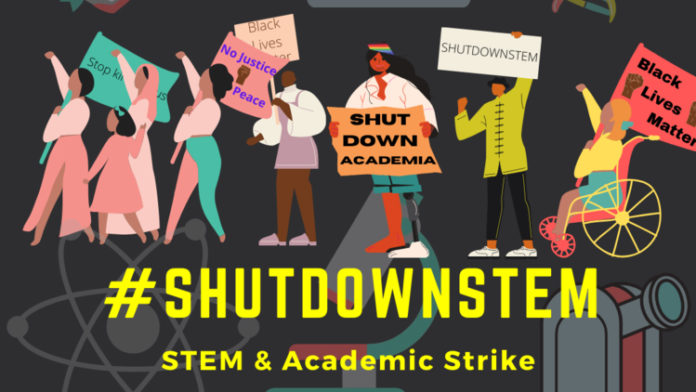What would compel a group of scientists to band together for a campaign with a hashtag like #ShutDownSTEM?
Earlier this week, they organized a day to hit pause on business as usual. Their goal is to shine an enduring spotlight on persistent anti-Black racism in STEM (Science, Technology, Engineering, and Math) and persuade their colleagues to join in on time to make long-term action plans to do better. They are demanding justice, reform, and accountability.
On June 10, the prestigious journal Nature suspended publication for a day in solidarity with the movement. The arXiv physics preprint server, an open-access archive where scientists can accelerate access to their research papers ahead of publication, silenced its daily announcements. And a growing list of researchers, including Canadian Nobel Prize-winning physicist Art McDonald, endorsed the shutdown.
Today we join #ShutDownSTEM #ShutDownAcademia #Strike4BlackLives. We will not publish Nature today and will instead take time to focus on what we can do better, and plan how we can play our part in eradicating anti-Black racism in academia and STEM. https://t.co/7cJg105daI
— Nature Portfolio (@NaturePortfolio) June 10, 2020
Even the sciences are vulnerable to bias
Diversity and representation are vital to the sciences. Just like how interdisciplinary collaboration lends wider perspectives on big problems, it’s equally important to engage people of colour to include their creativity and unique perspectives.
Despite science’s reputation as being an impartial and objective field, our experiences bias our observations and experimental plans, even if we’re not aware that it’s happening.
That’s why everyone benefits from having more diverse voices at the table. Racism impacts our institutions even if there are no literal segregation rules. It takes many forms aside from the more obvious expressions of hatred, including unequal access and socioecononomic disadvantage. We have unequal representation in our textbooks. Racism is even baked into language that we use, such as describing pairs of equipment of “masters” and “slaves”.
Black scientists face unequal opportunities for advancement. They’re more likely to be spoken over in classrooms and meetings. They have fewer Black mentors who understand the difficult path they’re on. In all, it contributes to an environment that is less welcoming.
Even with diversity initiatives and affirmative action, these programs have done little to move the dial on the number of Black graduates or Black representation in the STEM workforce.
How can researchers dismantle racism in their fields?
“We recognize that our academic institutions and research collaborations — despite big talk about diversity, equity, and inclusion — have ultimately failed Black people,” say physicist co-organizers Particles for Justice.
“Demands for justice have been met with gradualism and tokenism, as well as diversity and inclusion initiatives that — while sometimes well-intentioned — have had little meaningful impact on the lived experiences of Black students, staff, researchers, and faculty. Black representation among physics faculty is non-existent at most institutions, and it is widely known that Black students often feel unwelcome, unsupported, and even unsafe in their physics departments and predominantly white campuses.”
The organizers call on people to educate themselves, and not just by asking their Black friends and co-workers to do the tiring work of providing information. It’s often expected that people of colour lead the movement alone; taking on this additional work doesn’t help with the performance metrics they need to advance in their own careers and widens the divide. To help people get started, they compiled a list of books, articles, podcasts, videos, and even kid-friendly resources, and a list of prompts to create a personal action plan.
They are calling on scientists to reflect on the names of other people in their field that get said out loud, get cited in papers, who is given the space to speak, and whose ideas are amplified. If the demographic feels narrow, it’s time to seek out and broaden the scope of ideas we pay attention to.
To effect change at every level, they also call on funding agencies to examine, critique, change the demographics of who receives funding, and of who makes the decisions on which researchers get funded.
More broadly, society has an obligation to level the playing field by doing more than just extending more admissions to visible minorities. We need to foster the support systems needed for a more diverse set of graduates who will go on to have long and successful careers in STEM. That includes building up racialized communities in general.
“Importantly, we are not calling for more diversity and inclusion talks and seminars,” add the organizers at Particles for Justice.
“We are not asking people to sit through another training about implicit bias. We are calling for every member of the community to commit to taking actions that will change the material circumstances of how Black lives are lived — to work toward ending the white supremacy that not only snuffs out Black physicist dreams but destroys whole Black lives.”








































